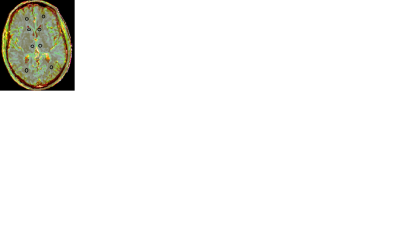4937
Imaging correlates of the Blood Brain Barrier disruption in HIV associated neuro cognitive disorder and therapeutic implications1Radiology, St Vincent's Hospital, Sydney, Australia, 2Neurology, St Vincents Hospital, Sydney, Australia
Synopsis
. Neurocognitive impairment in HIV infection, known as HIV associated neurocognitive disorder (HAND), in the context of suppressive combination antiretroviral therapy still occurs. We hypothesized that ongoing chronic systemic inflammation, a feature of HIV disease despite viral suppression, causes blood brain barrier (BBB) disruption thereby allowing entry of neurotoxic cytokines/chemokines or HIV itself (in very low levels because of suppression) thereby causing HAND or at least worsening it. To test this hypothesis, we have used dynamic contrast enhancement derived metrics (K-trans) to measure the capillary permeability as, a direct indicator for possible BBB disruption and correlated it with neuro inflammatory markers in the cerebrospinal fluid (CSF ) MR spectroscopy derived metabolites as well as with clinical indices of neurocognition (neuropsychological scores).
Synopsis
Neurocognitive impairment in HIV infection, known as HIV associated neurocognitive disorder (HAND), in the context of suppressive combination antiretroviral therapy still occurs. We hypothesized that ongoing chronic systemic inflammation, a feature of HIV disease despite viral suppression, causes blood brain barrier (BBB) disruption thereby allowing entry of neurotoxic cytokines/chemokines or HIV itself (in very low levels because of suppression) thereby causing HAND or at least worsening it. To test this hypothesis, we have used dynamic contrast enhancement derived metrics (K-trans) to measure the capillary permeability as, a direct indicator for possible BBB disruption and correlated it with neuro inflammatory markers in the cerebrospinal fluid (CSF ) MR spectroscopy derived metabolites as well as with clinical indices of neurocognition (neuropsychological scores).Methods
In this study, we used the DCE-MR metric K-trans to measure the BBB disruption in a cohort of 23 patients with HAND who were virally suppressed in both CSF and blood compared with 16 healthy age and sex matched volunteers. Measurement of K-trans, a marker for capillary permeability and hence BBB integrity, from different regions of the brain was compared to the age and sex matched controls using Wilcoxon rank-sum (Mann-Whitney) test. An analysis of co variance (ANCOVA) was performed with neuropsychological test scores to determine whether the increased permeability correlated with the neuropsychological test domains and laboratory derived neuroinflammatory markers: Neopterin and beta-2 Microglobulin. A covariate analysis was performed with spectroscopic markers of neuroinflammation (choline) and astrogliosis (Myoinositol) as well as excitotoxic markers (glutamates and glutamines) derived from interrogation of the striatum and frontal white matterResults
The K-trans data were significantly abnormal when compared to the normal controls in the region of basal ganglia (p=0.004) and anterior frontal white matter above the ventricular level (p=0.0129), while the corpus callosum and occipital white matter did not achieve any significance, nor did the CSF markers of neuroinflammation, neopterin and B-2 microglobulin. The neuropsychological scores (Z scores) demonstrated a strong negative correlation (increased K-trans was associated with reduced cognition) (Z: 0061; p: 0.0061 and Z: 2.69 & p: 0.0107) for the HAND group as compared to the normal controls in the basal ganglia and frontal white matter respectively. The membrane inflammation marker choline and the osmolite marker myoinositol showed positive correlation to increasing K-trans values while excitotoxic amines glutamates showed a strong negative correlation in both the striatum (p=0.000193 ) and frontal white matter (p=0.000161).Conclusion:
This study proved the hypothesis that HAND is associated with BBB disruption. The relationship to the severity of HAND as judged by neuropsychological testing and by MR spectroscopy makes the relationship to be more likely causal than associative. . However, the finding of region specific (areas known to be vulnerable to HIV) BBB disruption rather than globally and the lack of correlation with CSF markers of neuroinflammation suggests tthat 1. HIV and not systemic inflammation is driving the BBB disturbance and 2. That the BBB disruption is a consequence of HIV already in the brain as opposed to HIV first causing BBB disruption then brain disease. 3: Vasculopathy could be a contributing cause in BBB disruption. These findings generate novel testable hypotheses for HIAND pathogenesis with potentially significant therapeutic implications.Acknowledgements
References
1:Berger JR and Avison M. THE BLOOD BRAIN BARRIER IN HIV INFECTION. Frontiers in Bioscience. 2004, 9, 2680-2685.
2 :Anesten, B., Yilmaz, A., Hagberg, L., Zetterberg, H., Nilsson, S., Brew, B. J., … Gisslén, M. (2016). Blood–brain barrier integrity, intrathecal immunoactivation, and neuronal injury in HIV. Neurology® Neuroimmunology &Neuroinflammation, 3(6),e300.http://doi.org/10.1212/NXI.0000000000000300
3:Ivey, N. S., MacLean, A. G., & Lackner, A. A. (2009). AIDS and the blood-brain barrier. Journal of Neurovirology, 15(2), 111–122. http://doi.org/10.1080/13550280902769764.
4 :Armitage, P. A., Farrall, A. J., Carpenter, T. K., Doubal, F. N., & Wardlaw, J. M. (2011). Use of dynamic contrast-enhanced MRI to measure subtle blood–brain barrier abnormalities. Magnetic Resonance Imaging, 29(3), 305–314. http://doi.org/10.1016/j.mri.2010.09.002
5: 5:Heye, A. K., Culling, R. D., Valdés Hernández, M. del C., Thrippleton, M. J., & Wardlaw, J. M. (2014). Assessment of blood–brain barrier disruption using dynamic contrast-enhanced MRI. A systematic review. NeuroImage : Clinical, 6, 262–274. http://doi.org/10.1016/j.nicl.2014.09.002
